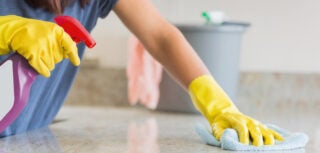- Resources
- Trend spotted: Home Depot is the latest retailer to drop these harmful chemicals
Resources
Trend spotted: Home Depot is the latest retailer to drop these harmful chemicals
Published: May 4, 2018 by EDF Staff
Last week The Home Depot published an update to their Chemical Strategy that expands their commitments to now cover household cleaning chemical products. They are asking suppliers to remove and exclude nine chemicals from these products by 2022. This commitment builds on their strategy first published in October 2017, which targeted chemicals of concern in flooring, carpet, insulation, and paints. Adding cleaning products to that portfolio builds on The Home Depot’s commitment to tackle products that impact the quality of indoor air. This commitment is important considering we spend 80% of our time indoors and many of the chemicals we are exposed to inside are linked to the development of asthma, among other health issues.
The Home Depot’s updated strategy is a move in the right direction for cleaning products. While they previously highlighted environmentally preferred products through the Eco Options® certification program, this commitment will impact all cleaning products sold in stores and online. This means more consumers will be able to bring safer products into their homes.
Retailers are increasingly aligning to eliminate or reduce these 9 harmful chemicals
Which chemicals are they asking suppliers to get out of? Here’s the list:
- Propyl-paraben
- Butyl-paraben
- Diethyl phthalate
- Dibutyl phthalate
- Formaldehyde
- Nonylphenol ethoxylates (NPEs)
- Triclosan
- Toluene
- Trichloroethylene (TCE)
Does this list look familiar? It might with the exception of TCE, these chemicals are also the High Priority Chemicals highlighted in Walmart’s policy. Target has also committed to removing phthalates, propyl-paraben, butyl-paraben, formaldehyde (and formaldehyde donors), and NPEs from household cleaning products by 2020. The Home Depot’s new commitments help to amplify a consistent message to suppliers that these particular chemicals of concern should be removed from cleaning products. This message will ripple through the supply chain, impacting more products than just those sold on the shelves of these retailers. Ultimately, more people will have greater access to safer products.
The Home Depot also highlights EPA’s Safer Choice label and Cradle to Cradle Certified™ products through their Eco Options® program. These certifications are credible and transparent about their ingredient assessment processes. Walmart’s policy also recommends these certifications to their suppliers. Retailers are aligning not only on which chemicals need to be eliminated, but also on what it means to increase the use of safer chemistry. Encouraging increased use of these certifications also makes it easier for consumers to recognize and understand what these labels mean, meaning they can make more informed purchasing decisions.
More progress needed
At EDF, we believe public communication about a company’s goals and their progress in achieving these goals is an important pillar of leadership on safer chemicals. We commend The Home Depot for publishing a policy update as they refine their goals. However, we would like to see more communication about how they plan to share updates with their consumers as they work towards these goals and importantly, how will they measure progress? Will they share progress regularly? Will they publish reports? It’s important to share the journey as well as the successes. There will be hurdles when a company tackles a new policy. Sharing how they overcome these hurdles and how they plan to make progress increases consumer confidence. Sharing the journey also helps create greater internal and supplier buy-in. It shows that a company is taking thoughtful and credible action to tackle a specific goal.
We also want to see more action from The Home Depot and all retailers regarding the removal of dangerous chemicals, like methylene chloride, from paint stripping products. Methylene chloride in paint stripping products has been responsible for dozens of reported deaths over the past several decades. The National Toxicology program has also identified the chemical as a likely carcinogen. One of the first acts of the EPA under the Lautenberg Chemical Safety Act, signed into law in 2016, was a proposed ban of methylene chloride in paint strippers based on a decades long rigorous assessment of the science that was issued in January 2017.Yet, in late 2017, the administration decided to delay these bans without any set deadline for action. Since the ban was proposed at least four individuals have died from methylene chloride while using paint strippers.
The EPA has delayed actions that could have potentially prevented unnecessary deaths. This is not the first time that this Administration has rolled back health protective measures, and it will not be the last. Retailers, including The Home Depot, have an opportunity to lead by taking stronger action on dangerous chemicals in paint strippers.
Follow Alissa Sasso on Twitter.
